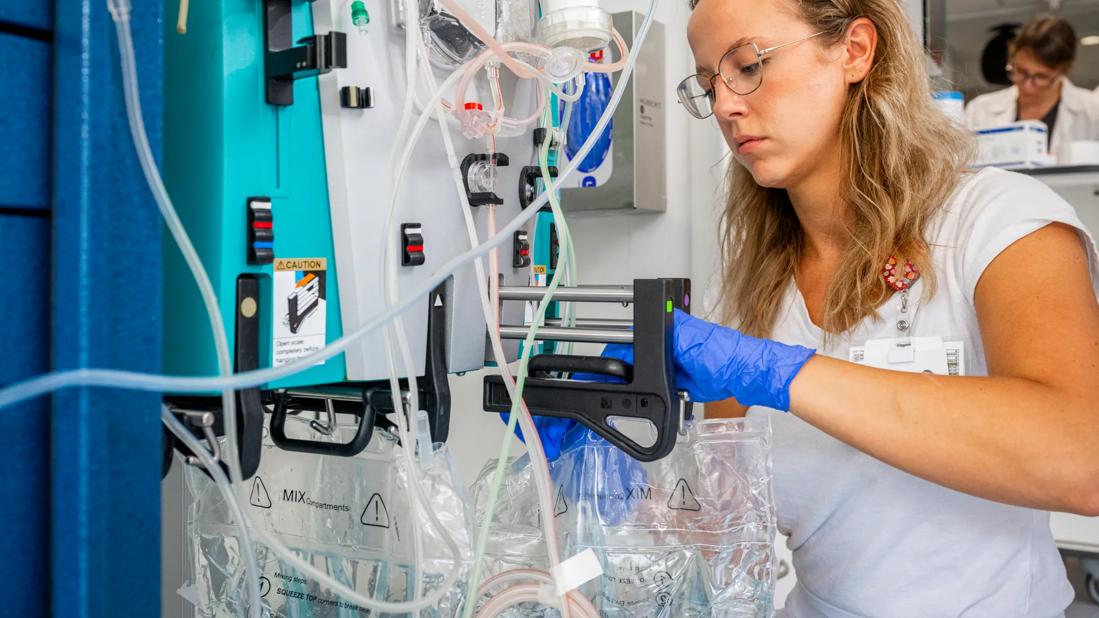Nurses play a critical role in delivering liver dialysis treatment

A multidisciplinary team in Cleveland Clinic’s Medical Intensive Liver Unit (MILU) has initiated a liver dialysis program — one of only 15 such programs in the United States and the only one of its kind in Ohio – that provides extended support for certain patients suffering from serious liver disease.
Advertisement
Cleveland Clinic is a non-profit academic medical center. Advertising on our site helps support our mission. We do not endorse non-Cleveland Clinic products or services. Policy
Molecular Adsorbent Recirculating System (MARS) therapy, or liver dialysis, is used as a bridge to medical recovery or liver transplant, says Paul Lamiell, MSN, RN, Nurse Manager in the MILU. “We care for hepatology patients who are critically ill within our medical intensive care unit,” Lamiell says. “These patients are closely followed by our staff intensivist and hepatology team, and the collaboration between these teams, as well as nursing, helps streamline their treatment.”
Cleveland Clinic care options allow patients to receive the best and most innovative therapies, Lamiell adds.
“While MARS is an older technology, our goal is to capitalize on it in new ways to help patients who may be too sick or ineligible for some traditional options. MARS therapy is just another tool to help them recover, gain functionality and have the best quality of life possible,” he says.
Patients currently eligible for MARS therapy include:
The MARS program leans heavily on nursing care. Since it began in 2021, 31 MICU nurses have been trained to run the MARS system, which requires an intense focus and a high level of expertise.
“Our nurses are the direct caregivers at the bedside. They partner with hepatology, nephrology and the MICU team to help determine if MARS therapy is viable for the patient,” Lamiell says. “If the teams decide to move forward with the treatment, a member of the nursing staff takes over.”
Advertisement
Setting up a patient for MARS is an extensive process. The nursing team coordinates with pharmacy and the supply chain teams to ensure all necessary supplies are at the bedside. From that point, it takes two to three hours to prepare for the treatment.
The preparation process includes drawing labs and assisting with establishing the appropriate dialysis line access. Setting up the dialysis and MARS circuits must be closely monitored, because the system is primed with dialysate, albumin and saline through specific channels and filters. Any error would require the process to be restarted, so the nurse must remain on site through the entire set-up.
“The nurse has to not only closely monitor the equipment they’re setting up, but they are still managing a patient who is critically ill or in liver failure itself,” Lamiell says.
These patients are still experiencing high acuity events, which require medication and blood pressure management as well as monitoring any bleeding or other side effects.
“Our nurses play a pivotal role in this therapy, not only during the initiation phase, but also while it is running. They’re continually watching the machine for air bubbles, making sure that the numbers are all correlating, and that the patients are doing well,” he says.
MARS therapy is conducted for eight hours every day for five days.
Success depends on the efforts of the multidisciplinary team, which includes physicians as well as representatives from nursing, hepatology, nephrology, pharmacy, supply chain and the MARS machine company, Lamiell adds.
Advertisement
“Everyone has a voice, and we continue to work together to meet our goals, which is ultimately to offer the best possible care to our patients,” he says.
Advertisement
Advertisement

Mobility carts provide exercises and tools

Nurse researchers explore the relationship between readmission risk scores and acute care transfers

Guiding nurses amid a constantly evolving healthcare landscape

Ideation session generates solutions to medication administration errors

Caregivers spearhead changes that improve patient care, shape hospital culture

Building a culture that supports, engages and empowers nursing staff

Nurses harness cutting-edge technology as a bridge to healing

Dedicated leader shares her passion for quality, education and professional development